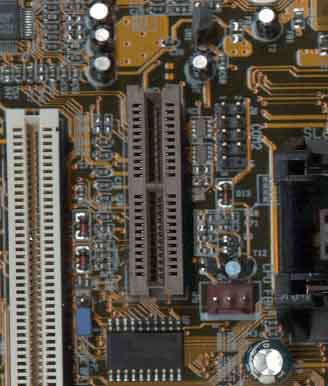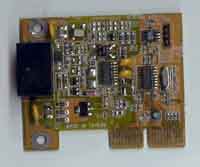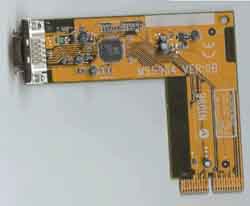I/O Controller Hub
The replacement for the South Bridge is the Intel 810 I/O Controller Hub (ICH). The ICH is the connecting force between the PCI bus, the USB ports, as well as a newcomer to the motherboard, the AMR slot. The ICH provides a direct connection to the 2 IDE channels (4 devices), the 2 USB ports, the PCI bus, and the Super I/O which drives the keyboard, mouse, FDD, serial and parallel ports. Like the GMCH, there are two distinct flavors of the ICH, a low and a high end.
The two versions, the ICH and the ICH0 differ only in the amount of PCI slots supported, as well as the type of Ultra ATA supported. The "high-end" solution, the ICH, supports Ultra ATA 66/33 and supports a maximum of 6 PCI slots with an optional ISA bridge. The "low-end" solution, the ICH0, supports Ultra ATA 33, and a maximum of 4 PCI slots with an optional ISA bridge. Although ISA bridges are supported by the chipset, it is highly unlikely that you'll see many 810 boards outfitted with ISA slots.
Audio Modem Riser
| It looks like 1/3 of an AGP slot, when in actuality it is the latest addition to the acronyms tech junkies will have to remember, AMR, or the Audio Modem Riser slot. The 810 chipset, if anything, is designed to be a highly integrated solution, and going along with the integrated motif is the optional inclusion of Audio/Telephony codecs. The inclusion of the Audio/Telephony codecs allows motherboard manufacturers to produce Audio/Modem ready mainboards without having to actually test and certify the components on the Audio/Modem cards themselves. Then, after producing and releasing the board, an optional AMR card can be installed that will provide the output ports for the Audio/Telephony devices. The reason this is a more cost effective solution is because the Audio/Telephony devices are software devices that are essentially powered by your CPU. For some users, a soft modem or soft audio device makes sense, because how much of a Celeron 466 will you be using while you're surfing the net? However, for others, it makes very little sense, such as having a soft audio/modem while playing some Quake 3 Arena on-line. |  |
Motherboard manufacturers will be offering hardware sound/modem devices as an option as well. Chances are that hardware sound will be a preferred option by gamers since you don't usually want to waste all too many clock cycles working on producing audio when they could be boosting your frame rate.
| Intel is working on developing/releasing a back panel for a single card AMR solution that would contain both audio and modem ports on it. With the major launch of the i810 chipset still some weeks away, by the time more manufacturers crank out 810 based products a standard back panel will have hit the streets as well. |
Other Features
There are a few other features of the ICH (common to both the ICH and the ICH0) that add to the 810's unique qualities. Borrowing a feature originally introduced by VIA based motherboards, i810 based motherboards will most likely offer support for front as well as rear USB ports, sharing the 2 ports allocated by the chipset. It makes more sense to have USB ports on the front of your case rather than on the back where you'd have difficulty reaching them if you wish to plug something in quickly, regardless, you'll most likely have the option of either front or the back with most 810 motherboards. Whether your case supports front panel USB ports is another question.
| Another unique feature some 810 boards will feature is a PTI port. Virtually indiscernible from an AMR slot in appearance, the PTI or PanelLink TV-Out Interface slot allows for the Flat Panel/Digital TV-Out capabilities of the GMCH to be taken advantage of. Microstar's MS-6182 features both an AMR and a PTI slot, offering the greatest expansion possible on an 810 board. |












1 Comments
View All Comments
xrror - Monday, December 8, 2014 - link
It's amusing in retrospect how difficult it was for Intel to obsolete the older BX chipset. One thing people forget is the venerable 440BX was actually the hi-end server chipset - it wasn't intended to be the bread and butter Slot 1 mainstream chipset. But all the mobo makers migrated to BX since the "mainstream" LX, MX, ZX chipsets were just gimped too much.But if you ever wondered why BX had things like support for 1GB (!) of RAM, dual-processor, ACPI, etc that we take for granted now - that's why. It was supposed to be a server chipset ;p